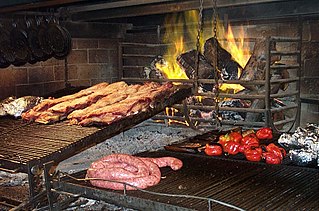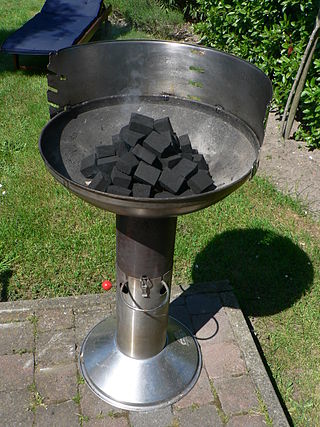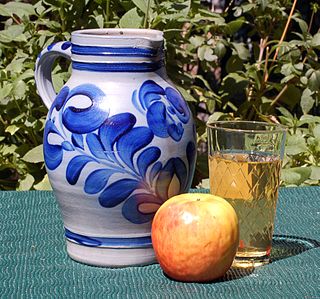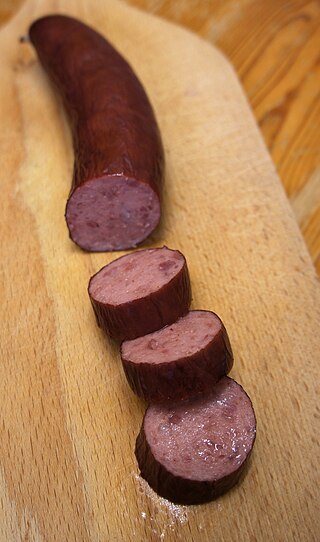
The cuisine of Germany consists of many different local or regional cuisines, reflecting the country's federal history. Germany itself is part of the larger cultural region of Central Europe, sharing many culinary traditions with neighbouring countries such as Poland and the Czech Republic. In Northern Europe, in Denmark more specifically, the traditional Danish cuisine had also been influenced by German cuisine in the past, hence several dishes being common between the two countries.

A sausage is a type of meat product usually made from ground meat—often pork, beef, or poultry—along with salt, spices and other flavourings. Other ingredients, such as grains or breadcrumbs may be included as fillers or extenders.

A hot dog is a food consisting of a grilled or steamed sausage served in the slit of a partially sliced bun. The term hot dog can refer to the sausage itself. The sausage used is a wiener or a frankfurter. The names of these sausages commonly refer to their assembled dish. Hot dog preparation and condiments vary worldwide. Typical condiments include mustard, ketchup, relish, onions in tomato sauce, and cheese sauce. Other toppings include sauerkraut, diced onions, jalapeños, chili, grated cheese, coleslaw, bacon, and olives. Hot dog variants include the corn dog and pigs in a blanket. The hot dog's cultural traditions include the Nathan's Hot Dog Eating Contest and the Oscar Mayer Wienermobile.

A blood sausage is a sausage filled with blood that is cooked or dried and mixed with a filler until it is thick enough to solidify when cooled. Most commonly, the blood of pigs, sheep, lamb, cow, chicken, or goose is used.

Scrapple, also known by the Pennsylvania Dutch name Pannhaas is traditionally a mush of pork scraps and trimmings combined with cornmeal and wheat flour, often buckwheat flour, and spices. The mush is formed into a semi-solid set loaf, and slices of the scrapple are then pan-fried before serving. Scraps of meat left over from butchering, not used or sold elsewhere, were made into scrapple to avoid waste. Scrapple is primarily eaten in the southern Mid-Atlantic region of the United States.

Asado is the technique and the social event of having or attending a barbecue in various South American countries, especially Argentina, Chile, Paraguay and Uruguay where it is also a traditional event. An asado usually consists of beef, pork, chicken, chorizo, and morcilla, all of which are cooked using an open fire or a grill, called a parrilla. Usually, red wine and side dishes such as salads accompany the main meats, which are prepared by a designated cook called the asador or parrillero.

A frikandel is a traditional snack originating from the historical Low Countries, a sort of minced-meat sausage, of which the modern version was developed after World War II. The history of this snack in the Spanish Netherlands goes back to the 17th century.

Vienna sausage is a thin parboiled sausage traditionally made of pork and beef in a casing of sheep's intestine, then given a low-temperature smoking. The word Wiener is German for 'Viennese'. In Austria, the term "Wiener" is uncommon for this food item, which instead is usually called Frankfurter Würstl.

Barbecue varies by the type of meat, sauce, rub, or other flavorings used, the point in barbecuing at which they are added, the role smoke plays, the equipment and fuel used, cooking temperature, and cooking time.

Cocido or cozido is a traditional stew eaten as a main dish in Spain, Portugal, Brazil and other Hispanophone and Lusophone countries.

A Schlachteplatte, Schlachtplatte, Schlachtschüssel or Metzgete is a hearty German dish that primarily consists of boiled pork belly (Kesselfleisch) and freshly cooked Blutwurst and Leberwurst sausages. The cooking process produces sausage juices which, together with any split sausages, are used as a soup known as Metzelsuppe. As a result, in many places, e.g. in parts of the Palatinate, the entire festival and the meal in particular are known as Metzelsupp.

The Ahle Wurst is a hard pork sausage made in northern Hesse, Germany. Its name is a dialectal form of alte Wurst – "old sausage". Ahle Wurst has protected geographical Status (g.g.A.) in Germany, the indication is only allowed to be used for sausages that are produced in the area of northern Hesse around its local capital Kassel.

Hessian cuisine is based on centuries-old recipes, and forms a major part of the Hesse identity. Reflecting Hesse's central location within Germany, Hessian cuisine fuses north German and south German cuisine, with heavy influence from Bavarian cuisine and Rhenish Hesse. Sour tastes dominate the cuisine, with wines and ciders, sauerkraut and handkäse with onions and vinegar popular.

Schüblig are various heavily smoked sausages made throughout the German-speaking part of Switzerland as well as the Black Forest and Lake Constance areas of southern Germany. Made of pork or beef, some schüblig are classified as dry sausage, while others are cooked smoked sausage. In Eastern Switzerland, Häsch Schüblig i de Ore? is a common saying when someone misunderstands and can't make out what is being said.

Salumeria Biellese is a historic Italian deli in Manhattan, New York City, established in 1925. It is located on 8th Avenue and 29th Street in the Chelsea neighborhood.

Kabanos, also known as cabanossi or kabana, is a long, thin, dry sausage usually made of pork which originated in Poland. They are smoky in flavor, and can be soft or very dry in texture depending on freshness. Typically, they are quite long, 60 cm (24 in), but very thin, with a diameter around 1 cm (0.39 in), and folded in two, giving them a characteristic appearance. Versions made of chicken and turkey are staples in kosher meat markets and delicatessens.

A salumeria is a food producer and retail store that produces salumi and other food products. Some only sell foods, while not producing on-site, and some have a restaurant with sit-down service. The salumeria originated in Italy, and dates to the Middle Ages.


















